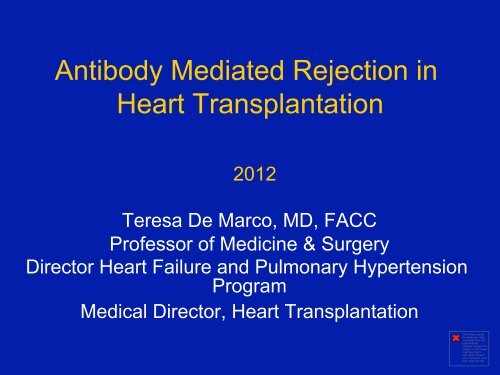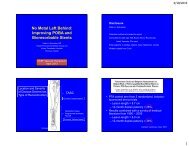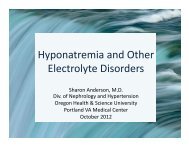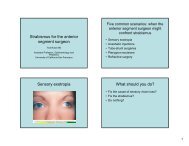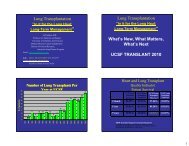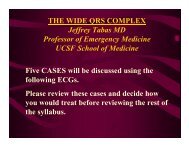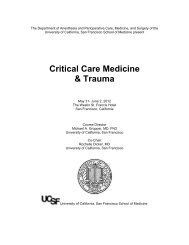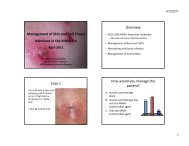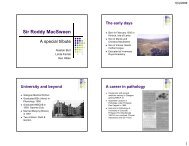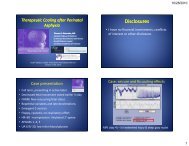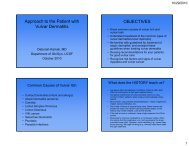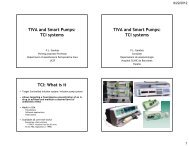Antibody Mediated Rejection in Heart Transplantation
Antibody Mediated Rejection in Heart Transplantation
Antibody Mediated Rejection in Heart Transplantation
Create successful ePaper yourself
Turn your PDF publications into a flip-book with our unique Google optimized e-Paper software.
<strong>Antibody</strong> <strong>Mediated</strong> <strong>Rejection</strong> <strong>in</strong><br />
<strong>Heart</strong> <strong>Transplantation</strong><br />
2012<br />
Teresa De Marco, MD, FACC<br />
Professor of Medic<strong>in</strong>e & Surgery<br />
Director <strong>Heart</strong> Failure and Pulmonary Hypertension<br />
Program<br />
Medical Director, <strong>Heart</strong> <strong>Transplantation</strong><br />
The image cannot<br />
be displayed. Your<br />
computer may not<br />
have enough<br />
memory to open the<br />
image, or the image<br />
may have been<br />
corrupted. Restart<br />
your computer, and<br />
then open the file
Disclosures<br />
• I will discuss off label use and/or<br />
<strong>in</strong>vestigational use of the follow<strong>in</strong>g<br />
drugs <strong>in</strong> my presentation: Rituximab,<br />
Bortezomib, Everolimus<br />
• I have no relevant relationships to<br />
disclose
<strong>Rejection</strong>
CARDIAC TRANSPLANTATION<br />
<strong>Rejection</strong><br />
• 0.5 to 1 episode per patient <strong>in</strong> year one
PERCENTAGE OF ADULT HEART TRANSPLANT RECIPIENTS<br />
EXPERIENCING REJECTION BETWEEN TRANSPLANT DISCHARGE AND 1-YEAR FOLLOW-UP<br />
Stratified by Ma<strong>in</strong>tenance Immunosuppression (Follow-ups: July 1, 2004 - June 30, 2008)<br />
% experienc<strong>in</strong>g rejection with<strong>in</strong> 1 year<br />
60 Cyclospor<strong>in</strong>e + MMF, Treatment Cyclospor<strong>in</strong>e + MMF, No Treatment<br />
Tacrolimus + MMF, Treatment Tacrolimus + MMF, No Treatment<br />
50<br />
40<br />
30<br />
20<br />
10<br />
0<br />
Overall<br />
Overall: p < 0.0001<br />
18-44: p < 0.0001<br />
45-62: p < 0.0001<br />
Female: p = 0.007<br />
Male: p < 0.0001<br />
ISHLT<br />
18-44 45-62 63+ Female Male<br />
Cyclospor<strong>in</strong>e + MMF: N = 2,360<br />
Tacrolimus + MMF: N = 3,065<br />
NOTE: There were 149 patients with cyclospor<strong>in</strong>e+AZA and 41 with<br />
tacrolimus+AZA. These groups were excluded due to small numbers.<br />
2009<br />
Analysis is limited to patients who were alive at the time of the follow-up<br />
Treated rejection = Recipient was reported to (1) have at least<br />
one acute rejection episode that was treated with an antirejection<br />
agent; or (2) have been hospitalized for rejection.<br />
No rejection = Recipient had (i) no acute rejection episodes<br />
and (ii) was reported either as not hospitalized for rejection or<br />
did not receive anti-rejection agents.
Types of <strong>Rejection</strong><br />
• Hyperacute rejection<br />
– Preformed alloantibodies vs. HLA class 1<br />
antigens<br />
• Acute rejection<br />
– Most common<br />
– Cell mediated<br />
– <strong>Antibody</strong> mediated - rare
Basic Transplant Immunology<br />
Two forms of acute rejection<br />
• Cellular rejection (CR)<br />
– CD4 and CD8 T cells target donor human<br />
leukocyte antigens (HLA) à� cytotoxic T cells<br />
à� cell damage<br />
• <strong>Antibody</strong>-mediated rejection (AMR)<br />
– B cells activate à� plasma cells à� antibodies<br />
aga<strong>in</strong>st HLA* à� complement-dependent<br />
cytotoxicity
HC I, II Antigens Corticosteroids<br />
Antigen Macrophage<br />
present<strong>in</strong>g cell<br />
AZA, MMF<br />
Cyclospor<strong>in</strong>,tacrolimus<br />
Plasma Cells<br />
Cyclospor<strong>in</strong>, tacrolimus<br />
Daclizumab
Antithymocyte/antilymphocyte Antithymocity globul<strong>in</strong> OKT3 globul<strong>in</strong> monoclonal antibody
Cl<strong>in</strong>ical signs of allograft rejection<br />
• None/asymptomatic/subcl<strong>in</strong>ical<br />
(surveillance RV bx and DSA monitor<strong>in</strong>g)<br />
• Non-specific<br />
• Fever<br />
• Elevated central venous pressure<br />
• New S3 gallop<br />
• New dysrrhythmias<br />
• Unexpected relative hypotension<br />
• Abnormal ventricular function<br />
• Cardiogenic shock
Right Ventricular Endomyocardial Biopsy<br />
3 specimen:<br />
False (-) 5%<br />
5 specimen:<br />
False (-) 3%<br />
Complications<br />
Mortality: 0.05%<br />
Cardiac perforation:<br />
0.3-0.5%<br />
PTX: 1%<br />
Thromboembolism,<br />
air embolism,<br />
arrhythmia, BBB
ISHLT 2004<br />
0<br />
1<br />
2<br />
3<br />
{<br />
{<br />
Grades of Acute Cellular <strong>Rejection</strong><br />
Grade Nomenclature<br />
0<br />
1A<br />
1B<br />
2<br />
3A<br />
3B<br />
4<br />
No rejection<br />
Focal (perivascular or <strong>in</strong>terstitial) <strong>in</strong>filtrate without<br />
necrosis<br />
Diffuse but sparse <strong>in</strong>filtrate without necrosis<br />
One focus with aggressive <strong>in</strong>filtration and/or focal<br />
myocyte damage<br />
Multifocal aggressive <strong>in</strong>filtrates and/or myocyte<br />
damage<br />
Diffuse <strong>in</strong>flammatory process with necrosis<br />
Diffuse aggressive polymorphous <strong>in</strong>filtrate<br />
+ edema, + hemorrhage, + vasculitis, with necrosis<br />
1= mild cellular rejection; 2 = moderate CR; 3 = severe CR
Grade 2R =<br />
MODERATE CR<br />
RX!<br />
IV steroid<br />
pulse or oral<br />
prednisone<br />
pulse<br />
- multifocal/diffuse lymphocytic <strong>in</strong>filtrate with<br />
myocyte necrosis
Challenges of<br />
<strong>Antibody</strong>-<strong>Mediated</strong> <strong>Rejection</strong><br />
• Diagnosis<br />
– Are symptoms required?<br />
– Cl<strong>in</strong>ical versus pathological?<br />
• Prevention<br />
– How do we identify patients at high risk for<br />
AMR?<br />
– Can high-risk patients be treated prior to<br />
transplant?<br />
• Treatment<br />
– How should AMR be treated?<br />
– If the <strong>in</strong>itial therapy fails, what next?
Cl<strong>in</strong>ical Characteristics of<br />
<strong>Antibody</strong>-<strong>Mediated</strong> <strong>Rejection</strong><br />
• 44 patients with AMR<br />
• More often female<br />
– 52% female<br />
(compared with 26%<br />
overall transplant<br />
population)<br />
• Hemodynamic<br />
compromise common<br />
– 47% of all cases<br />
– 68% of early cases<br />
Michaels PJ et al. <strong>Heart</strong> Lung Transplant 2003; 22: 58-69
Older Diagnostic Criteria:<br />
<strong>Antibody</strong>-<strong>Mediated</strong> <strong>Rejection</strong><br />
• Histologic evidence of acute<br />
capillary <strong>in</strong>jury : A and B<br />
required<br />
– A. Endothelial swell<strong>in</strong>g or<br />
denudation<br />
– B. Macrophages <strong>in</strong> capillaries<br />
– C. Neutrophils <strong>in</strong> capillaries<br />
– D. Interstitial edema, congestion,<br />
or hemorrhage<br />
• Immunopathologic evidence<br />
for antibody action<br />
– A. Ig (G,M, and/or A) + C3d and /<br />
or C4d or C1q<br />
– B. Fibr<strong>in</strong> <strong>in</strong> vessels (optional)<br />
• Serologic evidence of<br />
donor-specific anti-HLA Ab<br />
• Cardiac dysfunction<br />
required<br />
ACUTE CELLULAR REJECTION<br />
- Grade 1 R, mild: Interstitial<br />
and/or perivascular <strong>in</strong>filtrate with<br />
up to 1 focus of myocyte <strong>in</strong>jury.<br />
<br />
ANTIBODY-MEDIATED REJECTION (AMR/<br />
HUMORAL REJECTION)<br />
- AMR 1: Positive for antibodymediated<br />
rejection<br />
"<br />
Edema grade (0- 3) 1+<br />
Hemorrhage grade (0-3) 1+<br />
Capillary swell<strong>in</strong>g (0-3) 2+<br />
<br />
GENERAL IMMUNOHISTOCHEMISTRY REPORT<br />
<br />
C4d Positive<br />
CD20 Negative<br />
CD3 Negative<br />
CD31 Positive, highlights<br />
dilated vessels<br />
CD68 Positive, highlights<br />
numerous <strong>in</strong>tracapillary macrophages<br />
<br />
"<br />
Takemoto et al. Am J Transplant 2004;4:1033-41
Asymptomatic/Subcl<strong>in</strong>ical AMR: Increased risk of<br />
Cardiac Allograft Vasculopathy (CAV)<br />
43 with AMR<br />
21<br />
asymptomatic<br />
and untreated<br />
(AsAMR)<br />
1997 - 2001<br />
246 transplants<br />
86 controls<br />
matched for age,<br />
sex, time from tx<br />
22<br />
symptomatic<br />
(EF ≤ 40%)<br />
(TxAMR)<br />
9<br />
hemodynamic<br />
compromise<br />
Endothelial cell <strong>in</strong>jury!<br />
Wu et al, J <strong>Heart</strong> and Lung Transplant 2009; 28:417-22
1985 - 2004<br />
869 transplants<br />
118 AMR<br />
(≥ 3 AMR<br />
episodes)<br />
All<br />
asymptomatic<br />
and untreated<br />
Asymptomatic/Subcl<strong>in</strong>ical AMR:<br />
Increases Mortality<br />
Predom<strong>in</strong>ant pattern of<br />
rejection <strong>in</strong> first 3m post<br />
transplant<br />
490 CR<br />
(< 3 AMR<br />
episodes)<br />
All treated<br />
Excluded patients<br />
with hemodynamic<br />
compromise<br />
rejection<br />
193 mixed<br />
(≥ 3 mixed<br />
episodes)<br />
All treated<br />
Mortality over 7 yr avg f/u:<br />
CR: 12 %<br />
MR: 18 %<br />
AMR: 21 %<br />
Kfoury et al, J <strong>Heart</strong> and Lung Transplant 2009; 28:781-4
Asymptomatic AMR: Lessons Learned<br />
• Asymptomatic AMR if untreated:<br />
– Increased <strong>in</strong>cidence of CAV compared to patients<br />
with no AMR and patients with treated,<br />
symptomatic AMR<br />
– Increased mortality compared to patients with<br />
treated cellular or mixed rejection<br />
• Conclusion<br />
– The diagnosis of AMR should be pathological, not<br />
cl<strong>in</strong>ical<br />
– Asymptomatic AMR should be treated
New Diagnostic Criteria: AMR<br />
• Histology<br />
– Endothelial “activation”:<br />
<strong>in</strong>travascular macrophages,<br />
capillary destruction<br />
– Edema/hemorrhage less<br />
specific; not required<br />
• Immunopathology<br />
– Immunofluorescence: C3d, C4d,<br />
HLA deposition<br />
– Immunoperoxidase: C4d, CD68<br />
deposition<br />
Kobashigawa et al, J <strong>Heart</strong> and Lung Transplant 2011;30(3):252-269<br />
IMMUNOFLUORESCENCE RESULTS:<br />
IgG: 1+ <strong>in</strong>terstitial IgM: Negative<br />
IgA: Negative C'3: Negative<br />
C1q: Negative *HLA-Dr: 1+ vascular<br />
C4D: 3+ vascular C3D: Negative<br />
Fibr<strong>in</strong>ogen: 1+ <strong>in</strong>terstitial<br />
IMMUNOPEROXIDASE RESULTS:<br />
CD68: Stromal macrophages present<br />
CD31: Vascular endothelial cells highlighted<br />
C4D: Diffuse capillary sta<strong>in</strong><strong>in</strong>g<br />
C3D: Diffuse capillary sta<strong>in</strong><strong>in</strong>g<br />
RESULTS SUMMARY:<br />
X Immunologic positive<br />
Histology positive<br />
F<strong>in</strong>d<strong>in</strong>gs of severe rejection<br />
ANTIBODY-MEDIATED REJECTION CLASSIFICATION:<br />
AMR 0: None. Negative immunologic sta<strong>in</strong>(s) and negative<br />
histology.<br />
X AMR 1: Suspicious. Positive immunologic sta<strong>in</strong>(s) or<br />
histology (but not both).<br />
AMR 2: Def<strong>in</strong>ite. Positive immunologic sta<strong>in</strong>(s) and<br />
positive<br />
histology.<br />
AMR 3: Severe. Positive immunologic sta<strong>in</strong>(s) and<br />
positive<br />
histology with hemorrhage, edema, neutrophils,<br />
vasculitis.
Diagnostic Criteria:<br />
<strong>Antibody</strong> <strong>Mediated</strong> <strong>Rejection</strong><br />
• New pathologic diagnostic criteria<br />
pAMR 0: both histological and immunopathological<br />
studies are negative<br />
pAMR 1(H+):suspicious for pathologic AMR<br />
histopathological alone<br />
pAMR 1 (I+): suspicious for pathologic AMR<br />
immunopathological alone<br />
pAMR 2: both histological and immunopathological<br />
studies are positive<br />
pAMR 3: severe AMR; <strong>in</strong>terstitial hemorrahge, capillary<br />
fragmentation, mixed <strong>in</strong>flammatory <strong>in</strong>filtrates, endothelial<br />
cell pyknosis, and /or karyorrhexis, marked edema<br />
• Serologic evidence of donor specific<br />
anti-HLA Ab and non-HLA antibodies<br />
Berry, G et al. J <strong>Heart</strong> Lung Transplant 2011. 30( 6):601-11
<strong>Antibody</strong>-<strong>Mediated</strong> <strong>Rejection</strong><br />
H<br />
&<br />
E Intravascular<br />
cells; no<br />
lymphocytes<br />
A B<br />
I<br />
m unoperoxidase<br />
C<br />
CD68<br />
Prom<strong>in</strong>ent<br />
macrophages<br />
EC;Intravascuar<br />
E macrophages F<br />
D<br />
CD3<br />
Rare T<br />
lymphocytes<br />
CD34 C4d<br />
Complement<br />
<strong>in</strong> capillaries<br />
Courtesy Michelle Kittleston from Wu, G et al J <strong>Heart</strong> Lung Transpl 2009;28:417-22
EC swell<strong>in</strong>g;<br />
Macrophages<br />
C4D sta<strong>in</strong><br />
Surrounds EC<br />
Gonzales-Staw<strong>in</strong>ski GV et al J <strong>Heart</strong> Lung Transplant 2008;27:375-61
C4D label<strong>in</strong>g with<br />
cardiac dysfunction<br />
Bruneval, P ISHLT Newsletter<br />
Focal C4D label<strong>in</strong>g without<br />
cardiac dysfunction<br />
Positive DSA<br />
MFI = 8,000
Recommended Frequency<br />
for Rout<strong>in</strong>e Monitor<strong>in</strong>g<br />
Endomyocardial Biopsy<br />
• Histologic evaluation of every protocol biopsy for AMR<br />
• Immunoperoxidase/immunofluorescent sta<strong>in</strong><strong>in</strong>g (C4d):<br />
– Post-transplant: 2 weeks and 1, 3, 6, 12 months, and<br />
– AMR suspected<br />
• Interval test<strong>in</strong>g for C4d<br />
– AMR suspected on histologic, serologic, or cl<strong>in</strong>ical<br />
f<strong>in</strong>d<strong>in</strong>gs<br />
• Rout<strong>in</strong>e C4d sta<strong>in</strong><strong>in</strong>g on subsequent biopsy specimens<br />
after a positive result until clearance<br />
Kobashigawa et al, J <strong>Heart</strong> and Lung Transplant 2011;30(3):252-269
Recommended Frequency<br />
for Rout<strong>in</strong>e Monitor<strong>in</strong>g<br />
Circulat<strong>in</strong>g <strong>Antibody</strong><br />
• Use of solid-phase assay and/or cell-based<br />
assays to:<br />
– Assess for DSA (& quantification if Ab present)<br />
– Post-transplant: 2 weeks and 1, 3, 6, 12<br />
months, and annually, and<br />
– AMR cl<strong>in</strong>ically suspected<br />
Kobashigawa et al, J <strong>Heart</strong> and Lung Transplant 2011;30(3):252-269
Challenges of<br />
<strong>Antibody</strong>-<strong>Mediated</strong> <strong>Rejection</strong><br />
• Diagnosis<br />
– Are symptoms required? No<br />
– Cl<strong>in</strong>ical versus pathological? Pathological<br />
• Prevention<br />
– How do we identify patients at high risk for<br />
AMR?<br />
– Can high-risk patients be treated prior to<br />
transplant?<br />
• Treatment<br />
– How should AMR be treated?<br />
– If the <strong>in</strong>itial therapy fails, what next?
<strong>Antibody</strong>-<strong>Mediated</strong> <strong>Rejection</strong>:<br />
Prevention<br />
• Targets of the antibody response<br />
– Human leukocyte antigens (HLA)<br />
– Endothelial cell antigens<br />
• Risk factors: sensitization<br />
– Blood transfusions<br />
– Pregnancy<br />
– Previous transplant<br />
– VAD<br />
• Goal: identify sensitized patients<br />
– Anti-HLA Ab aka Panel Reactive Antibodies<br />
(PRA)<br />
– Non-HLA Ab (experimental)
Assess<strong>in</strong>g Panel Reactive Antibodies:<br />
Screen<strong>in</strong>g for the Presence of Antibodies<br />
• Screen<strong>in</strong>g<br />
– Low Risk: PRA < 10%<br />
– Moderate Risk:<br />
PRA 10-25%<br />
– High Risk: PRA > 25%<br />
• Specification<br />
– Identification of<br />
anti-HLA Ab<br />
• Quantification<br />
– Are they cytotoxic?<br />
Survival %<br />
Nwakanma LU Annals Thoracic Surg 2007 84:1556-1563
<strong>Antibody</strong> Detection Methods<br />
Membrane-Based<br />
Peripheral Leukocytes<br />
or Cell L<strong>in</strong>es<br />
Complement Dependent Cytotoxicity (CDC)<br />
● Lacks sensitivity for all HLAs<br />
● Cannot detect HLA Class II reliably<br />
● Cannot dist<strong>in</strong>guish IgM from IgG<br />
Solid Phase<br />
ELISA<br />
Fluorescent Bead Assays<br />
● Lum<strong>in</strong>ex<br />
● Flow PRA<br />
● Specification of s<strong>in</strong>gle HLA<br />
Class I and II IgG Ab<br />
- Quantification of HLA Ab<br />
(<strong>in</strong>dication of cytotoxicity)<br />
- Rapid turn-around time
Assess<strong>in</strong>g Panel Reactive Antibodies:<br />
Identification by Fluorescent Bead Assays<br />
• Screen<strong>in</strong>g<br />
– Low = PRA < 10%<br />
– Moderate = PRA<br />
10-25%<br />
– High = PRA > 25%<br />
• Specification<br />
– Identification of<br />
anti-HLA Ab<br />
• Quantification<br />
– Are they cytotoxic?<br />
Laser<br />
Freq<br />
Fluorescence
Assess<strong>in</strong>g Panel Reactive Antibodies:<br />
Quantification by Fluorescent Bead Assays<br />
• Screen<strong>in</strong>g<br />
– Low = PRA < 10%<br />
– Moderate = PRA<br />
10-25%<br />
– High = PRA > 25%<br />
• Specification<br />
– Identity of anti-HLA Ab<br />
• Quantification<br />
– Are they cytotoxic?<br />
Mean<br />
Fluorescent<br />
Intensity<br />
(MFI)<br />
Weak < 5,000<br />
Moderate<br />
Strong<br />
(Cytotoxic)<br />
5,000 -10,000<br />
> 10,000
What matters cl<strong>in</strong>ically:<br />
Calculated PRA<br />
• How easy will it be to f<strong>in</strong>d a<br />
donor for my patient await<strong>in</strong>g<br />
transplant?<br />
• cPRA def<strong>in</strong>es the frequency of<br />
the unacceptable HLA <strong>in</strong> the<br />
donor population<br />
• Step 1: Def<strong>in</strong>e unacceptable<br />
HLA<br />
– Potentially cytotoxic :<br />
MFI > 5000<br />
– Patient has anti-HLA Ab<br />
with MFI > 5000<br />
à� unacceptable HLA<br />
- PANEL REACTIVE ANTIBODY SCREEN<br />
- ANTIBODY CLASS II % PRA 75 <br />
- ANTIBODY CLASS I % PRA 78<br />
<br />
- SINGLE ANTIBODY ID CLASS I<br />
<br />
- MFI<br />
- B78: 6829<br />
- B51: 6537<br />
- B37: 5717<br />
- B75: 3996<br />
- B35: 3190<br />
- B53: 2748<br />
- B76: 2521<br />
- B52: 2455<br />
- A66: 2397<br />
- A26: 2164<br />
- A25: 2125<br />
"<br />
- - SINGLE ANTIBODY ID CLASS II<br />
<br />
- MFI<br />
- DR7: 14135<br />
- DQ7: 7789<br />
- DQ9: 6256<br />
- DQ8: 4472<br />
- DR12: 4403<br />
- DR103: 4111<br />
- DR53: 3268"
What matters cl<strong>in</strong>ically:<br />
• How easy will it be to f<strong>in</strong>d<br />
a donor for my patient<br />
await<strong>in</strong>g transplant?<br />
• cPRA def<strong>in</strong>es the<br />
frequency of the<br />
unacceptable HLA <strong>in</strong> the<br />
donor population<br />
• Step 2: Determ<strong>in</strong>e<br />
frequency of those HLA <strong>in</strong><br />
the population<br />
– L<strong>in</strong>k on UNOS website<br />
Calculated PRA<br />
http://optn.transplant.hrsa.gov/resources/professionalResources.asp?<strong>in</strong>dex=78
What matters cl<strong>in</strong>ically:<br />
The Calculated PRA<br />
• How easy will it be to f<strong>in</strong>d<br />
a donor for my patient<br />
await<strong>in</strong>g transplant?<br />
• cPRA def<strong>in</strong>es the<br />
frequency of the<br />
unacceptable HLA <strong>in</strong> the<br />
donor population<br />
• Step 3: Assess cPRA<br />
– cPRA 10% = 90% of<br />
donors would be a<br />
match<br />
– cPRA 80% = only 20%<br />
of donors would be a<br />
match<br />
cPRA 53% = only 47%<br />
donors would be a match<br />
http://optn.transplant.hrsa.gov/resources/professionalResources.asp?<strong>in</strong>dex=78
Pre-transplant Protocol:<br />
Management of Sensitized Patients<br />
< 10%<br />
Recheck<br />
• Q 6 m<br />
• 2w post sensitiz<strong>in</strong>g<br />
event<br />
• Infection<br />
• Transfusion<br />
Check PRA<br />
Prospective vs<br />
Virtual Xmatch<br />
Kobashigawa JA J <strong>Heart</strong> and Lung Transplant 2009; 28:213-25<br />
> 10%<br />
• Specification<br />
(anti-HLA Ab)<br />
• Quantification (MFI)<br />
Calculated PRA<br />
Desensitization<br />
if cPRA > 50%
Desensitization Protocols<br />
• Adapted from renal transplantation experience<br />
• Indications<br />
– Pre-transplant cPRA > 50% to prevent AMR<br />
– Post-transplant<br />
• Positive Xmatch (<strong>in</strong>duction)<br />
• Refractory AMR<br />
• Components<br />
– Remove preformed Ab: Plasmapheresis<br />
– Block Ab function: IV IgG<br />
– B cell destruction: Monoclonal Ab aga<strong>in</strong>st<br />
CD20 on B cells – Rituximab<br />
– Plasma cell destruction: Proteasome<br />
<strong>in</strong>hibitor target<strong>in</strong>g plasma cells – Bortezomib<br />
• FDA approved for multiple myeloma
Desensitization Protocols<br />
• Indications<br />
– Pre-transplant<br />
cPRA > 50%<br />
– Post-transplant<br />
• Positive Xmatch<br />
(<strong>in</strong>duction)<br />
• Refractory AMR<br />
Vo AA NEJM 2008 359: 242-51
Desensitization Protocol:<br />
Manag<strong>in</strong>g Refractory Antibodies<br />
• Some patients have a<br />
persistently elevated<br />
PRA despite<br />
plasmapheresis, IV Ig<br />
and rituximab<br />
Median fluorescent <strong>in</strong>tensity<br />
20000<br />
18000<br />
16000<br />
14000<br />
12000<br />
10000<br />
8000<br />
6000<br />
4000<br />
2000<br />
0<br />
Drop after 1 st<br />
round of PP, IV<br />
Ig, ritux<br />
Rebound after 2 nd<br />
round of IV Ig, ritux<br />
1/4/09 3/3/09 3/26/09 4/22/09<br />
DR7<br />
DQ7<br />
DQ9<br />
B78<br />
B51<br />
Drop after<br />
bortezomib
Refractory Antibodies:<br />
Role of Bortezomib<br />
Cedar S<strong>in</strong>ai experience<br />
• 6 patients with cPRA ≥ 50% despite<br />
PP/IV Ig/ritux<br />
• Side effects<br />
– UTI, pneumonia, catheter<br />
<strong>in</strong>fection, C difficile<br />
– Neuropathy: responded to<br />
reduction <strong>in</strong> dose<br />
• Outcomes<br />
– cPRA ê� from 62% to 35%<br />
– 5 with fall <strong>in</strong> cPRA and<br />
successfully transplanted<br />
– 1 with no Δ <strong>in</strong> cPRA and died<br />
from sepsis after cycle #2<br />
– 1 died post-OHT from sepsis<br />
cPRA ≥ 50% after IV Ig/ritux<br />
protocol<br />
Days 1, 4,<br />
8, 11<br />
Day 25<br />
Repeat 2-wk cycle if<br />
cPRA ≥ 50%<br />
Plasmapheresis<br />
Bortezomib<br />
1.3 mg/m 2<br />
Check PRA<br />
Patel et al J <strong>Heart</strong> and Lung Transp 2011; 30:1320
Prospective Crossmatch<br />
• Purpose<br />
– Avoid donors with HLA to which<br />
the recipient has cytotoxic anti-<br />
HLA antibodies<br />
– Prevent hyperacute rejection<br />
• Process<br />
– Test recipient serum aga<strong>in</strong>st<br />
donor cells<br />
– Geographic constra<strong>in</strong>ts to limit<br />
the donor pool<br />
• Indications<br />
– Pre-transplant, if multiple<br />
low-level anti-HLA Ab<br />
(MFI 2000-5000)<br />
– Post-transplant surveillance<br />
T CELL FLOW CROSSMATCH POSITIVE "<br />
T CELL MCS 51 "<br />
"<br />
T cell MCS Reference range:"<br />
<strong>Heart</strong> : Negative < 50 MCS <br />
"<br />
B CELL FLOW CROSSMATCH NEGATIVE<br />
B CELL MCS 65 "<br />
"<br />
B cell MCS Reference range: <br />
H e a r t : N e g a t i v e < 1 2 1 M C S "
Virtual Crossmatch<br />
• Purpose<br />
– Avoid donors with HLA for which<br />
the recipient has strong anti-HLA<br />
Ab<br />
– Prevent hyperacute rejection<br />
• Advantages<br />
– Does not require donor cells +<br />
recipient serum<br />
– No geographic constra<strong>in</strong>ts<br />
• Process<br />
– Step 1: def<strong>in</strong>e cytotoxic HLA Ab<br />
by MFI threshold (> 5000-7000)<br />
– Step 2: avoid donors with these<br />
HLA<br />
• Higher MFI threshold<br />
– More donor offers<br />
– Greater chance of rejection<br />
– Reserved for unstable patients<br />
with projected long wait time<br />
- PANEL REACTIVE ANTIBODY SCREEN<br />
- ANTIBODY CLASS II % PRA 75 <br />
- ANTIBODY CLASS I % PRA 78<br />
<br />
- SINGLE ANTIGEN ID CLASS I<br />
<br />
- MFI<br />
- B78: 6829<br />
- B51: 6537<br />
- B37: 5717<br />
- B75: 3996<br />
- B35: 3190<br />
- B53: 2748<br />
- B76: 2521<br />
- B52: 2455<br />
- A66: 2397<br />
- A26: 2164<br />
- A25: 2125<br />
"<br />
- - SINGLE ANTIGEN ID CLASS II<br />
<br />
- MFI<br />
- DR7: 14135<br />
- DQ7: 7789<br />
- DQ9: 6256<br />
- DQ8: 4472<br />
- DR12: 4403<br />
- DR103: 4111<br />
- DR53: 3268"
257 samples from<br />
highly sensistized pts<br />
Virtual Xmatch<br />
Prospective vs Virtual Crossmatch<br />
Incompatible<br />
(+)<br />
Compatible<br />
(-)<br />
Prospective Xmatch<br />
Incompatible<br />
(+)<br />
Compatible<br />
(-)<br />
89 23<br />
12 133<br />
89/112<br />
PPV 79%<br />
133/145<br />
NPV 92%<br />
• PPV 79% à� 21% false-<strong>in</strong>compatible rate à� yet donor<br />
pool is still expanded by lack of geographical<br />
constra<strong>in</strong>ts<br />
• NPV 92% à� 8% of patients will have <strong>in</strong>compatible<br />
matches à� use retrospective Xmatch post transplant to<br />
guide therapy<br />
Stehlik et al. J <strong>Heart</strong> and Lung Transplant 2009;28:1129-34.
Prognostic Value of Post-transplant PRA<br />
Study Post-tx<br />
PRA<br />
Smith JD<br />
<strong>Transplantation</strong> 1992<br />
George JF<br />
JHLT 1995<br />
Przybylowski P<br />
<strong>Transplantation</strong> 1999<br />
Tambur AR<br />
<strong>Transplantation</strong> 2000<br />
Ho EK<br />
Human Immunology<br />
2009<br />
Anti-HLA<br />
DSA<br />
Anti-HLA<br />
DSA<br />
Anti-HLA<br />
DSA<br />
Anti-HLA<br />
DSA<br />
Anti-HLA<br />
DSA<br />
Outcome<br />
↑ 6-month rejection<br />
↓ 1-year survival<br />
↑ 1-year rejection (50% vs 16%)<br />
↓ 1-year survival (86% vs 92%)<br />
↑ 1-year rejection<br />
↓ 10-year survival (63% vs 79%)
Challenges of<br />
<strong>Antibody</strong>-<strong>Mediated</strong> <strong>Rejection</strong><br />
• Diagnosis<br />
– Are symptoms required?<br />
– Cl<strong>in</strong>ical versus pathological?<br />
• Prevention<br />
– How do we identify patients at high risk for<br />
AMR?<br />
– Can high-risk patients be treated prior to<br />
transplant?<br />
• Treatment<br />
– How should AMR be treated?<br />
– If the <strong>in</strong>itial therapy fails, what next?
Mechanisms Underly<strong>in</strong>g Treatment of AMR<br />
Rituximab<br />
Anti-thymocyte<br />
globul<strong>in</strong><br />
Rituximab<br />
Proliferation<br />
signal <strong>in</strong>hibitors<br />
Anti-thymocyte<br />
globul<strong>in</strong><br />
Bortezomib<br />
IV immune<br />
globul<strong>in</strong><br />
Plasmapheresis<br />
Photopheresis<br />
Adapted from S<strong>in</strong>gh et al, <strong>Transplantation</strong> Reviews, 2009;23:34-46
Cellular<br />
<strong>Antibody</strong>-<strong>Mediated</strong><br />
Asymptomatic/<br />
Subcl<strong>in</strong>ical<br />
• Target higher<br />
CNI levels<br />
• Oral steroid<br />
bolus + taper<br />
• Sirolimus<br />
To treat or not<br />
to treat ?<br />
Treatment of <strong>Rejection</strong><br />
Reduced EF<br />
• Oral steroid bolus/<br />
taper<br />
or<br />
• IV pulse steroids<br />
• IV pulse steroids<br />
or<br />
• Cytolytic therapy<br />
• Plasmapheresis<br />
(before ATG dose)<br />
• IV immune globul<strong>in</strong><br />
<strong>Heart</strong> Failure/Shock<br />
• IV pulse steroids<br />
• Cytolytic therapy<br />
(ATG)<br />
• Plasmapheresis<br />
( before ATG dose)<br />
• IV immune globul<strong>in</strong><br />
• Inotropic therapy<br />
• IV hepar<strong>in</strong><br />
• Inotropes, IABP<br />
or ECMO support
Cellular<br />
<strong>Antibody</strong>-<strong>Mediated</strong><br />
Asymptomatic/<br />
Subcl<strong>in</strong>ical<br />
• Target higher<br />
CNI levels<br />
• Oral steroid<br />
bolus + taper<br />
• Sirolimus<br />
To treat or not<br />
to treat ?<br />
Treatment of <strong>Rejection</strong><br />
Reduced EF<br />
• Oral steroid bolus/<br />
taper<br />
or<br />
• IV pulse steroids<br />
• IV pulse steroids<br />
or<br />
• Cytolytic therapy<br />
• Plasmapheresis<br />
(before ATG dose)<br />
• IV immune globul<strong>in</strong><br />
<strong>Heart</strong> Failure/Shock<br />
• IV pulse steroids<br />
• Cytolytic therapy<br />
(ATG)<br />
• Plasmapheresis<br />
(before ATG dose)<br />
• IV immune globul<strong>in</strong><br />
• Inotropic therapy<br />
• IV hepar<strong>in</strong><br />
• IABP or ECMO<br />
support
Acute therapy<br />
determ<strong>in</strong>ed by<br />
cl<strong>in</strong>ical picture<br />
Normal EF/hemos,<br />
no DSA, no rejection<br />
EMBx/echos per<br />
protocol<br />
PRA q 6m<br />
After the dust settles. . .<br />
AMR Ma<strong>in</strong>tenance Protocol<br />
MMF à� PSI<br />
Repeat echo, EMBx,<br />
PRAs 1-2w post rx<br />
Photopheresis<br />
Persistent low EF,<br />
abnormal hemos, or DSA<br />
?<br />
IV Ig, rituximab,<br />
bortezomib
Evidence for AMR therapies<br />
Study Organ Therapy #pts Results<br />
Crespo-Leiro MG<br />
Am J Transplant<br />
2005<br />
Jordan SC<br />
Pediatr<br />
Transplant 2005<br />
Garrett HE<br />
JHLT 2005<br />
<strong>Heart</strong> PP 7-19d<br />
Kidney IV Ig +/-<br />
PP<br />
12 pts 11/12 had resolution<br />
of AMR<br />
20 pts 15/20 had resolution<br />
of AMR<br />
<strong>Heart</strong> Rituximab 8 pts 8/8 had resolution of<br />
AMR
Proliferation signal <strong>in</strong>hibitors (PSIs)<br />
� Mechanism<br />
l� Inhibit proliferation of T, B,<br />
smooth muscle,<br />
endothelial cells<br />
� In cl<strong>in</strong>ical trials<br />
l� ↓ rejection, CAV<br />
l� ↓ viral <strong>in</strong>fections<br />
l� ↑ renal <strong>in</strong>sufficiency<br />
l� Impaired wound heal<strong>in</strong>g<br />
� Indications for sirolimus/<br />
everolimus<br />
l� <strong>Rejection</strong><br />
l� CAV<br />
l� Malignancy<br />
l� Viral <strong>in</strong>fections (CMV)<br />
l� Renal dysfunction (i/o<br />
CNI)<br />
Incidence of treated rejection<br />
Kobashigawa et al. Am J Transplant 2006;6:1377-86.
Refractory Antibodies:<br />
Role of Bortezomib<br />
Cedar S<strong>in</strong>ai experience<br />
• 6 patients with cPRA ≥ 50% despite<br />
PP/IV Ig/ritux<br />
• Side effects<br />
– UTI, pneumonia, catheter<br />
<strong>in</strong>fection, C difficile<br />
– Neuropathy: responded to<br />
reduction <strong>in</strong> dose<br />
• Outcomes<br />
– cPRA ê� from 62% to 35%<br />
– 5 with fall <strong>in</strong> cPRA and<br />
successfully transplanted<br />
– 1 with no Δ <strong>in</strong> cPRA and died<br />
from sepsis after cycle #2<br />
– 1 died post-OHT from sepsis<br />
cPRA ≥ 50% after IV Ig/ritux<br />
protocol<br />
Days 1, 4,<br />
8, 11<br />
Day 25<br />
Repeat 2-wk cycle if<br />
cPRA ≥ 50%<br />
Plasmapheresis<br />
Bortezomib<br />
1.3 mg/m 2<br />
Check PRA<br />
Patel et al J <strong>Heart</strong> and Lung Transp 2011; 30:1320
Photopheresis<br />
• Pr<strong>in</strong>ciple<br />
– “Immunomodulation”<br />
– Promote destruction of cytotoxic T<br />
cells aga<strong>in</strong>st the donor heart<br />
• Procedure<br />
– Leukapheresis: remove white cells<br />
– Photoactivation: mix cells with<br />
psoralen and expose to UV light à�<br />
apoptosis<br />
– Re<strong>in</strong>fusion<br />
• Role <strong>in</strong> rejection<br />
– Tested <strong>in</strong> primary prevention and<br />
recurrent rejection<br />
– Reduction <strong>in</strong> rejection and<br />
coronary <strong>in</strong>timal medial thickness<br />
(marker for CAV)<br />
Marques MB J Cl<strong>in</strong> Apheresis 2006: 72-77.
Photopheresis<br />
60 pts, standard therapy vs<br />
photopheris q wk for 6 months<br />
post- OHT<br />
- Decrease <strong>in</strong> acute rejection<br />
- Did not look at humoral<br />
rejection<br />
Barr ML NEJM 1998; 339: 1744-51.<br />
36 pts with recurrent<br />
rejection<br />
3-12 mon photopheresis<br />
Risk of rejection or death<br />
reduced after 3 months<br />
Kirkl<strong>in</strong> JK JHLT 2006; 25: 283-288
Cl<strong>in</strong>ical Characteristics of<br />
<strong>Antibody</strong>-<strong>Mediated</strong> <strong>Rejection</strong><br />
• 44 patients with AMR<br />
• Higher <strong>in</strong>cidence of<br />
CAV (stenosis > 30%)<br />
– 1 year: 16% vs 5%<br />
– 3 years: 36% vs 17%<br />
– 5 years: 64% vs 30%<br />
Michaels P J <strong>Heart</strong> Lung Transplant 2003; 22: 58-69
Year 0<br />
Year 2<br />
Year 1
25 yr M 3 yrs S/P OHT noncompliant<br />
with IMS<br />
• Admitted <strong>in</strong> cardiogenic shock<br />
EF
Challenges of<br />
<strong>Antibody</strong>-<strong>Mediated</strong> <strong>Rejection</strong><br />
• Diagnosis<br />
– Are symptoms required?<br />
– Cl<strong>in</strong>ical versus pathological?<br />
• Prevention<br />
– How do we identify patients at high risk for<br />
AMR?<br />
– Can high-risk patients be treated prior to<br />
transplant?<br />
• Treatment<br />
– How should AMR be treated?<br />
– If the <strong>in</strong>itial therapy fails, what next?
<strong>Antibody</strong>-<strong>Mediated</strong> <strong>Rejection</strong>:<br />
Summary<br />
• Diagnosis<br />
– Pathological f<strong>in</strong>d<strong>in</strong>gs only<br />
• Prevention<br />
– Assays for specification and quantification of<br />
HLA Ab<br />
– cPRA and virtual crossmatch<br />
– Desensitization target<strong>in</strong>g B cells, plasma cells,<br />
and antibodies<br />
• Treatment<br />
– Subcl<strong>in</strong>ical AMR should be treated<br />
– Long-term therapy: photopheresis vs<br />
densensitization<br />
• Close monitor<strong>in</strong>g for complications
AMR: Conclusion<br />
• Difficult problem <strong>in</strong> heart transplantation-requires high<br />
<strong>in</strong>dex of suspicion<br />
• Associated with <strong>in</strong>creased morbidity and mortality<br />
• Evidence based therapeutic strategies are limited


